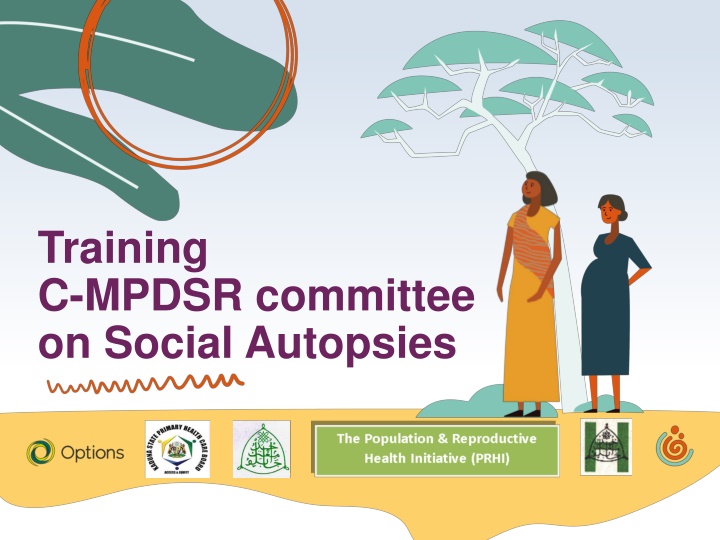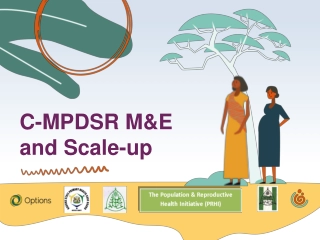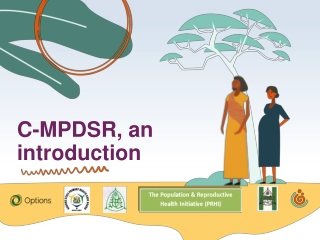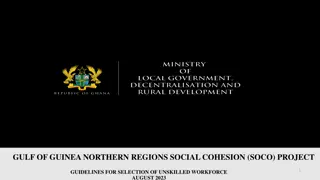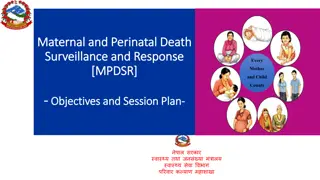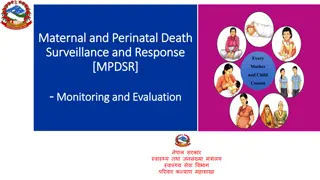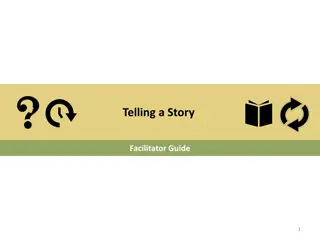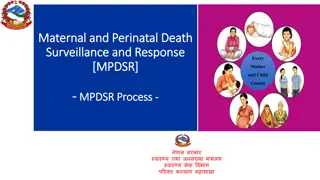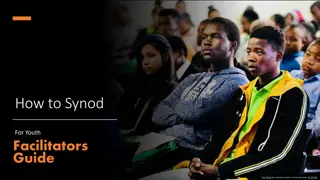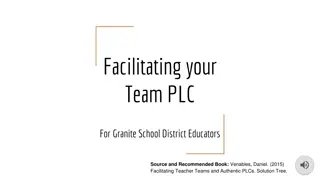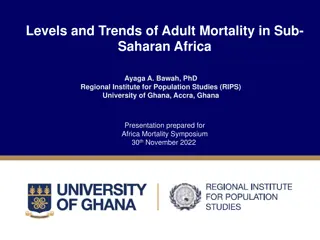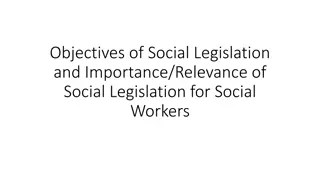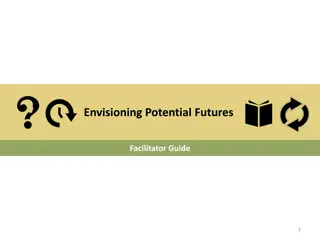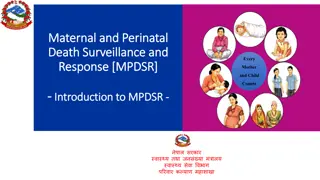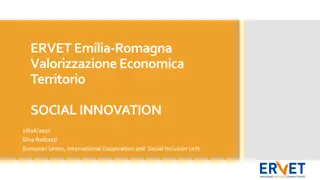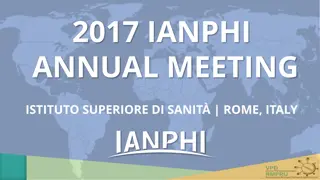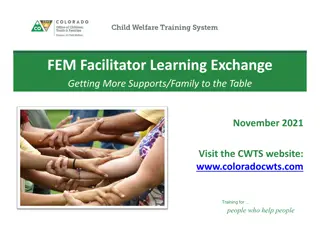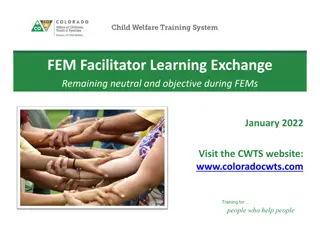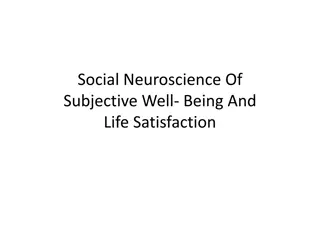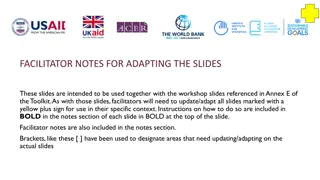Facilitator Guide for Training Community Members on C-MPDSR and Social Autopsies
This module provides guidance for facilitators training community members on implementing C-MPDSR and conducting Social Autopsies. It covers key considerations such as participants' lack of experience in health interventions, varied literacy levels, volunteer status, and past exposure to maternal and perinatal deaths. The guide offers strategies for successful training delivery, emphasizing clear instructions, individual support, and managing group dynamics effectively. It also highlights what not to do, such as avoiding distractions and lecturing participants.
Download Presentation

Please find below an Image/Link to download the presentation.
The content on the website is provided AS IS for your information and personal use only. It may not be sold, licensed, or shared on other websites without obtaining consent from the author.If you encounter any issues during the download, it is possible that the publisher has removed the file from their server.
You are allowed to download the files provided on this website for personal or commercial use, subject to the condition that they are used lawfully. All files are the property of their respective owners.
The content on the website is provided AS IS for your information and personal use only. It may not be sold, licensed, or shared on other websites without obtaining consent from the author.
E N D
Presentation Transcript
Training C-MPDSR committee on Social Autopsies
This module is for Facilitators who train c-MPDSR committees on implementing c- MPDSR and conducting Social Autopsies
Facilitator guide: How to train community members Key things to consider: They may have little to no experience of delivering health interventions There will be varied levels of literacy They are volunteers with competing priorities They may have been affected by issues such as maternal and perinatal deaths in the past They are embedded within and participants to socio-cultural norms that may need to change to strengthen health seeking behaviour They will have adult styles of learning that may differ within the group You might not have access to a computer or projector, so be prepared to deliver this via flip charts Anything else?
Facilitator guide: How to train community members Strategies to deliver a successful training: As the facilitator, you need to be very familiar with the material and able to give explanations, answer questions, talk with participants about their answers to exercises, lead group discussions, and generally give participants any help they need to successfully complete the training. Instruct participants clearly and explain any information participants find confusing so everyone understands what they are expected to do. Look for signs of participants struggling e.g., looking troubled, staring into space, not writing answers, or not turning pages. Spend extra time with participants who are struggling. Motivate participants by complimenting their progress and improvements and presenting the content of the training in an enthusiastic manner Manage the training so that all necessary equipment and supplies are available and there are no obstacles to learning (e.g. too much noise, not enough light, etc.) Stay aware of power dynamics in the room, for instance between men and women, and try to ensure that everyone has the chance to contribute and is listened to. Ensure there is space and time to learn from the experiences of participants themselves by asking questions and giving time for discussion.
Facilitator guide: How to train community members What NOT to do: Do not work on other projects whilst delivering the training, or look distracted or uninterested in the content Avoid using facial expressions or making comments that could cause participants to feel embarrassed Do not call on participants one by one or otherwise use methods that are used in teaching children Do not lecture on the material, provide the introductory explanations and then support participants to learn it themselves through the activities and discussions Do not go through the material too fast, look for indications from participants for the appropriate speed to ensure they are keeping up with you
Facilitator guide: Who should be present? Chairman Ward Development Committee (Chairman) Representative of the Community Leader Representative of religious bodies Officer In charge of the Ward Focal PHC (Secretary) Community Health Practitioners (Community Health Officers/Community Health Extension Workers) Representative of the WDC in the PHC facility quality improvement team A community TBA representative/Traditional healers. Local Government - Ward Councillor representing the community Representatives of Community based Organizations (CBOs) Ward level National Population council (NPC) Members Any other community member that may be necessary. Community Health Influencers, Promoters and Services (CHIPS) agent and/ or other community volunteers
Facilitation training on Social Autopsy Part 1 Activity
What killed Hauwakuluwa? Hauwakuluwa* was a 30-year-old illiterate woman who lived in Nano village. Getting transport was difficult as vehicles come that village only on market days. When they got one, the driver doubled the price. She was married to a 45-year-old farmer at the age of 13, as the third wife. The nearest health facility, the PHC, was 10km away. When they got there in the evening, the health workers had closed. She had 7 children, all born at home, under the supervision of a TBA. She never had ANC nor delivered in a health facility as she was told by her mother in-law that no woman in that house ever did such a thing. Eventually, they reached the general hospital, which was 35 km from their village. She was examined and diagnosed as having obstructed labour due to transverse lie. They were asked to pay 35,000 before admission. When she was due to have her eighth delivery, she encountered problems. She laboured for 2 days without progress. The TBA gave her concoctions, without success. The Malam was called, who gave her rubutu to drink, all without relief. The husband went to the back to the village to raise the money. By the time he came back Hauwakuluwa had died Finally, at the end of day 2 of labour, the TBA advised that she be taken to the hospital. Initially, the husband refused, but later he gave his consent. *name changed to ensure anonymity
What caused Hauwakuluwas death? Medically, the cause of death is obstructed labour. But many other socio-cultural, behavioral and health systems related factors, which are all modifiable, significantly contributed to the mortality. E.g. high parity, lack of ANC, delivering at home, use of traditional medicine, husband s refusal to visit the health facility, transport difficulties, unavailability of healthcare workers, financial challenges/inappropriate charges, etc. Social Autopsies
What is a Social Autopsy? A social autopsy follows maternal and perinatal death. It is a structured group interaction with the family of the deceased woman/baby and the wider local community, where facilitators explore the social causes of the death, identify improvements needed, and communicate them within the community to aid future prevention. Why are they useful? The process facilitates self-diagnosis and leads to identification of modifiable socio-cultural, behavioural and health system factors contributing to the maternal or perinatal death. They support communities to work together with health facilities and take ownership of socio-cultural and behavioural changes needed to achieve a sustainable impact on preventable maternal and perinatal deaths. They are an opportunity to share behaviour change communication on key maternal and perinatal health interventions (importance of ANC, birth preparedness and complication readiness and importance of health facility delivery under the supervision of a skilled birth attendant).
What is a Verbal Autopsy? A verbal autopsy is a method used to determine the cause of death in cases where a person dies outside of a hospital or other medical facility, or when the cause of death is not immediately known. It involves interviewing the person's family members, friends, and caregivers to gather information about the person's symptoms, medical history, and circumstances leading up to their death. This information is then used by medical professionals to infer the cause of death. Verbal autopsies are commonly used in low-income countries where access to medical care and death registration systems may be limited. They can help public health officials better understand the causes of death in a population and identify potential interventions to prevent similar deaths in the future. With regards to maternal and perinatal deaths, VAs also provide an opportunity for understanding cultural norms and beliefs, the use of dangerous or inappropriate traditional practices, and first and second delays in receiving pregnancy care. VA precedes social autopsy and generates the report that will be used during the social autopsy to develop actions across the healthcare system.
Steps in conducting a Social Autopsy 1. 2. 3. 4. 5. 6. Select deaths to include in the SA Request consent to include these deaths in the SA Venue & time for the SA agreed Participants invited to the SA Facilitators for the SA identified and prepped Conduct SA i. ii. Welcome remarks and reminder of purpose and ground rules Facilitator provides a summary of the circumstances surrounding the maternal and perinatal deaths Facilitator leads discussion on modifiable contributing factors Facilitator supports participants to develop and commit to actions to prevent similar occurrences in future Updates on past actions taken and results achieved are shared iii. iv. v.
1. Select deaths to include in the SA Why is it important? To support principles of no blaming and no naming, it is best for the SA to focus on multiple deaths in the past 3 months to avoid people to forget about the details. However, too many deaths could also pose facilitation challenges. Hence, we think having 2-3 maternal deaths and 2-3 perinatal deaths (max. 5 in total) will help to ensure a focused discussion and more specific actions designed. ACTIVITY: How should the deaths be selected? Who makes the selection? What are the selection criteria?
1. Select deaths to include in the SA ANSWERS: How should the deaths be selected? Who makes the selection? The C-MPDSR committee selects the deaths for inclusion in the social autopsy based on the verbal autopsy report of the deaths. Prioritize deaths with underlying economic or socio-cultural factors as root causes of death. What are the selection criteria? It must be a maternal or perinatal death that has occurred in the community or PHC within the last three months. Maternal Death is the death of a woman while pregnant or within 42 days of termination of pregnancy, but not from accidental or incidental causes. Perinatal death is death at the time of birth; it includes both stillbirths and deaths during the first seven days of life. There must be a verbal autopsy report about the deaths.
2. Request consent to include these deaths in the SA Why is it important? Given the sensitive nature of maternal and perinatal deaths it is vital that the family are aware of what information is shared in a social autopsy and consent for their family member s death to be included. The SA should anonymize the death as much as possible by removing identifying characteristics such as name, age (instead giving an age bracket), and location. The details that will be shared should be agreed by the family. ACTIVITY: How should consent be obtained? Who should make the request? How do they make the request? What information on the death can be shared publicly? What should not be shared? How can you teach community members to understand and uphold principles of informed consent and anonymization?
2. Request consent to include these deaths in the SA ANSWERS: How should consent be obtained? Who should make the request? The request should be made by a member of the c-MPDSR committee How do they make the request? The request should be made after the verbal autopsy has been conducted What information on the death can be shared publicly? What should not be shared? Demographic information (the person's age, gender, and other demographic characteristics), cultural and social context (such as information about the person's cultural background, social relationships, and community norms may be relevant to understanding the context in which the event occurred), information about the physical environment in which the person lived and worked, and importantly, the circumstances leading up to the death, including any relevant events, activities, or conditions, that may be useful in understanding the cause of the death. During a social autopsy, it is important to respect the privacy and confidentiality of the person who has died and their family members. Information that should not be shared includes personal identification or contact information, sensitive medical information, and anything the family has asked to be kept private. It is important to carefully consider the potential impacts of sharing any information and to take appropriate precautions to protect sensitive information. How can you teach community members to understand and uphold principles of informed consent and anonymization? These principles should be re- emphasized at the start of every social autopsy. Those who disrespect the principles should be asked to leave.
3. Venue & time for the SA agreed Why is it important? The venue should be somewhere accessible to everyone and neutral within the community, i.e. not within or too close to the health facility or any dwellings. For instance, school premises might work well. Also, the location should allow for confidential/sensitive conversations to happen so it should be away from crowds or noisy places. If possible, it would be important to allow for women to come in with their babies or children as they often do not have alternative care arrangements. The time of the SA should allow most people in the community to join. For instance, not when another community meeting is held, on market days, during working hours, or when women have specific domestic chores to attend. ACTIVITY: How to agree the venue and time of the SA? Who decides the venue and timing? What are possible venues that can be proposed? What timings are most suitable?
3. Venue & time for the SA agreed ANSWERS: How to agree the venue and time of the SA? Who decides the venue and timing? The venue and timing should be decided by the c-MPDSR committee and the Ward Development Committee What are possible venues that can be proposed? The community town hall, school premises, Palace premises anywhere accessible and neutral (i.e. not the health facility) What timings are most suitable? This will vary from one place to another, and even from one season to another. It is best to schedule when most people are not engaged in other activities such as market days or farming. The c-MPDSR committee should be able to determine a suitable time.
4. Participants invited to the SA Why is it important? The community needs to be represented to ensure that actions are agreed and owned by everyone. SA participants should represent the whole community to ensure that the actions designed consider different life experiences and perspectives. This means equal representation of genders and ages, as well as people of different ethnic or religious groups, people with disability, poorer or richer, etc. Additionally, community gatekeepers such as community leaders, health workers, traditional birth attendants, local government representatives should be there so that they can feed in and lend support to the implementation of actions. Finally, it is important to invite family and friends affected so they feel included and are aware of what information is ultimately shared and the actions designed. ACTIVITY: Who should be invited to the SA? Make a list of all possible stakeholders to be invited Is there anyone who MUST attend? How can we ensure an equal gender and age split, and that everyone feels able to contribute equally? How can we ensure marginalized individuals and groups are represented safely? How will people be invited? Do people have to be invited or can anyone with interest attend?
4. Participants invited to the SA ANSWERS: Who should be invited to the SA? Make a list of all possible stakeholders to be invited See next slide Is there anyone who MUST attend? There should be at least one representative from the deceased family, at least one healthcare worker present, and at least one representative from the Ward Development Committee. How can we ensure an equal gender and age split, and that everyone feels able to contribute equally? It is important that the facilitators maintain an atmosphere of respect by reprimanding anyone How can we ensure marginalized individuals and groups are represented safely? Ensure the location is physically accessible. Make sure to actively seek input and feedback from marginalized individuals and ensure that their voices are heard and considered in group decision-making How will people be invited? Do people have to be invited or can anyone with interest attend? Members of the community will be invited by a member of the c- MPDSR committee. For those that hear by word of mouth, they should seek guidance from a member of the c-MDPSR committee who is rude, aggressive, or disrespects anyone (whether they are present at the SA or not). Ensure that the group has clear and fair guidelines to establish clear expectations for behavior and communication and help create a safe and respectful environment for all members of the group. E.g. No name, no blame, respect everyone s opinion, when someone talks, others should listen, no strong language or discriminatory language should be used, and time management Facilitators should ensure that the group does not use any stigmatizing or discriminatory language and terminology, instead encouraging use of inclusive and respectful language that is free from bias or stereotypes.
4. Participants invited to the SA Ward and village heads List of all possible stakeholders to be invited Traditional Birth Attendances Representatives of family members of the deceased Religious leaders (Christian and Moslem) Neighbors of the deceased Representatives of CBOs and community groups, schoolteachers Women in the community Non-indigenous group representative Health workers from PHC People with physical or mental disabilities representative LGA Personnel C-MPDSR Committee Members Elderly women Household heads (Men)
5. Facilitators for the SA identified and prepped Why is it important? Good facilitation is vital to the success of the SAs. They need to be able to discuss sensitive issues, guide conversation, encourage people to participate, and communicate accurate information clearly. Without good facilitation, SAs may upset family members, cause arguments, and be ineffective in designing practical, strong actions. ACTIVITY: How are facilitators identified and prepped? Who should be a facilitator? Who should select the facilitators for each SA? What should be the criteria for selection? What are strong facilitation skills? How can we train community members in facilitation? What are the risks of bad facilitation and how can we mitigate these? How should facilitators prepare?
5. Facilitators for the SA identified and prepped ANSWERS: How are facilitators identified and prepped? Who should be a facilitator? There should be a facilitator and a co-facilitator, including a healthcare worker and a member of the c-MDPSR committee, such as the chairman or secretary of the c-MPDSR committee. The facilitators should have no relationship with the deceased. Who should select the facilitators for each SA? The chairman and secretary of the c-MPDSR committee should select the facilitator What should be the criteria for selection? Strong facilitation skills, well respected in the community, good communication skills, good listening skills, good understanding of what causes maternal and perinatal deaths. What are strong facilitation skills? Being able to facilitate discussion in a respectful, inclusive, and informative manner. More information can be found in the SA facilitation guide How can we train community members in facilitation? For skills such as this, lots of practice is needed! There is a role play at the end of this training. What are the risks of bad facilitation and how can we mitigate these? Risks of bad facilitation include causing additional suffering for the family of the deceased, rifts developing within the community, or misinformation spreading, amongst others. We can mitigate these by spending time practicing facilitation skills and preparing well for each social autopsy How should facilitators prepare? Facilitators should be well acquainted with the details of each death being presented and have a few starter questions and probing questions ready to use. More information can be found in the SA facilitation guide
6. Conducting an SA i. ii. Welcome remarks and reminder of purpose and ground rules Facilitator provides a summary of the circumstances surrounding the maternal and perinatal deaths Facilitator leads discussion on modifiable contributing factors Facilitator supports participants to develop and commit to actions to prevent similar occurrences in future Updates on past actions taken and results achieved are shared iii. iv. v. ACTIVITY: Is there anything missing?
Conducting a hypothetical SA Part 2 Activity
Role play activity Please can two people volunteer to be Social Autopsy facilitators Everyone else, please assume the role of a community member who may be present at a social autopsy (examples to follow) We are going to run a practice social autopsy please take part and engage with the questions as you imagine your assumed role would do Any questions?
Role play activity You might be Hawakuluwaa s husband, mother, father, in-law, brother, sister, child, friend A newly married adolescent girl aware of the expectation on her to birth a child soon A mother-in-law who has had numerous children with TBAs and faced no complications A female friend of Hawakuluwaa s who supports engaging early with the health system to stop this repeating with herself or other friends An older woman who has witnessed the loss of a number of family members and seeks change A very religious man who does not want to interfere with God s will A widowed man raising adolescent girls and wants to protect them A young man, the son of a traditional leader and keen to support his father Anyone you can think of that might attend a social autopsy in the community!
Facilitator Tips: For this activity, the participants who have volunteered to facilitate the social autopsy should have time to read through and understand the social autopsy facilitation guide, available here.
SA Agenda (for the facilitators) i. ii. Welcome remarks and reminder of purpose and ground rules Facilitator provides a summary of the circumstances surrounding the maternal and perinatal deaths Facilitator leads discussion on modifiable contributing factors Facilitator supports participants to develop and commit to actions to prevent similar occurrences in future Updates on past actions taken and results achieved are shared iii. iv. v.
Social Autopsy example mortality case Hauwakuluwa* was a 30-year-old illiterate woman who lived in Nano village. She was married to a 45-year-old farmer at the age of 13, as the third wife. She had 7 children, all born at home, under the supervision of a TBA. She never had ANC nor delivered in a health facility as she was told by her mother in-law that no woman in that house ever did such a thing. When she was due to have her eighth delivery, she encountered problems. She laboured for 2 days without progress. The TBA gave her concoctions, without success. The Malam was called, who gave her rubutu to drink, all without relief. Finally, at the end of day 2 of labour, the TBA advised that she be taken to the hospital. Initially, the husband refused, but later he gave his consent. Getting transport was difficult as vehicles come that village only on market days. When they got one, the driver doubled the price. The nearest health facility, the PHC, was 10km away. When they got there in the evening, the health workers had closed. Eventually, they reached the general hospital, which was 35 km from their village. She was examined and diagnosed as having obstructed labour due to transverse lie. They were asked to pay 35,000 before admission. The husband went to the back to the village to raise the money. By the time he came back Hauwakuluwa had died *name changed to ensure anonymity
Role play activity reflection What went well? What could have gone better? What would you change about the process itself?
Access the Social Autopsy Facilitation Guide Wrench with solid fill
E4A-MamaYe C-MPDSR Pack Evidence for Action (E4A) - MamaYe is a programme led by African experts in Kenya and Nigeria to improve the Maternal and Newborn Health. It is managed by Options Consultancy Services Ltd with funding from the Bill & Melinda Gates Foundation. The findings and conclusions contained within are those of the authors and do not necessarily reflect positions or policies of the Bill & Melinda Gates Foundation. FURTHER INFORMATION This guidance was produced by E4A-MamaYe in collaboration with Kaduna State government and Population and Reproductive Health Initiative (PRHI) to design and implement a sustainable and scalable community Maternal, Perinatal, Death Surveillance & Response (c-MPDSR).
